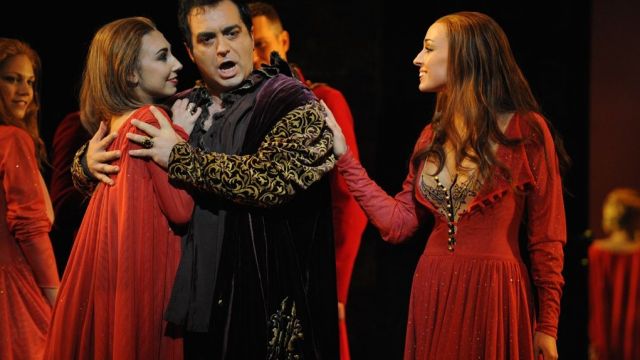Rigoletto
The elegant design of the program conjures the mood of this production, which is a stunning collaboration of music and voices, direction and design. It seems a little strange to suggest that the program heralds the colour and atmosphere that will predominate on the stage and the elegant lines of the set, but it does.
The lights fade to the brief, almost static notes of Verdi’s 34-bar prelude, and the curtain rises on the clean lines of a magnificent set, which continues to amaze as it moves and turns seamlessly, smoothly changing the scenes from lavish court to less lavish courtyard. A cloudy sky frames outdoor scenes, constantly moving and changing. Surreptitious lighting brings subtle atmosphere in early acts, but becomes more complex in the final scenes where projections and shadows are almost part of the performance.
Certainly designers Richard Roberts (set) and Matt Scott (lighting) have taken on board director Roger Hodgman’s vision of “a set that was simple, flexible and capable of changing quickly from scene to scene … and evokes Renaissance Italy but uses modern materials”.
 Tracy Grant’s costumes are equally impressive. Red predominates, in every shade and weight of fabric, from the highly decorated uniforms of the gentry and the elaborate gowns of the noble women to the flimsy, figure-hugging dresses of the Duke’s young ladies. Here, Rigoletto, in dull brown is almost unnoticed until, in his jester’s hat, he leers and taunts the nobles, earning their dislike and disdain. Another telling contrast is his daughter Gilda’s gown, it’s almost white translucence emphasising her innocence.
Tracy Grant’s costumes are equally impressive. Red predominates, in every shade and weight of fabric, from the highly decorated uniforms of the gentry and the elaborate gowns of the noble women to the flimsy, figure-hugging dresses of the Duke’s young ladies. Here, Rigoletto, in dull brown is almost unnoticed until, in his jester’s hat, he leers and taunts the nobles, earning their dislike and disdain. Another telling contrast is his daughter Gilda’s gown, it’s almost white translucence emphasising her innocence.
And so the set, lighting and costumes prepare the way for one of the most performed of Verdi’s operas. The story is one that is not popular with feminists – the Duke’s attitude to women in general, the court’s acceptance of this, the need for Gilda to be closeted away to protect her from men in general – and is in itself a sad commentary on the morals of the time. Yet these themes gave Verdi the chance to compose some exceptionally lyrical, emotionally charged music.
From the Duke’s harsh, swaggering, egotistical rhythms and the light-hearted carnival atmosphere of the court, to Rigoletto’s heart-felt entreaties to his daughter, to the beautiful notes of Gilda’s aria (her only solo in the opera), the music is varied and atmospheric, allowing the gentle notes of individual instruments – a solo violin, the haunting notes of the oboe – to echo emotions and suggest danger and heartache to come.
As the various plots thicken, and Rigoletto becomes increasingly convinced of the efficacy of La Maledizione (the curse put upon him by Count Monterone), the music becomes more sinister, building to a powerful crescendo as, in a violent storm, Rigoletto is robbed of the daughter he loves so much.
Beautiful duets are a musical and dramatic feature of this opera, but more thrilling is Verdi’s bringing together of the voices of four characters (the Duke, Sparafucile, his sister Maddalena and Gilda) simultaneously in “an intricate and perfectly balanced quartet … uniting four sets of conflicting emotions within a single tinta or mood … Flirtation, devastation and the resolution to take revenge are all given life in the same musical breath.” (Melissa Lesnie).
Opera Australia has assembled a wonderful cast for this production. Giogio Caoduro is a beleaguered Rigoletto. Disfigured and ridiculed, he lunges and darts around the court but with Gilda he is loved and respected and rises in stature and self-esteem. Here he sings with the power of love rather than the power of hate and despair that rings in his voice in other scenes.

Emma Matthews is beguilingly naïve and trusting as Gilda. The notes of her aria ring out with almost overpowering clarity and linger with the soft notes of the orchestra as she wistfully climbs the stairs and leaves the stage.
Gialuca Terranova is brash and brutal as the Duke of Mantua. He brings all of his vast experience to the role and the strength and power of his voice echoes, especially in the famous ‘La donna e mobile’.
They are supported by other well-loved opera stars, among them David Corcoran as Borsa, Samuel Dundas as Count Ceprao, Dominica Matthews as Giovanna, Sian Pendry as Maddalena, Eleanor Greenwood as Countess Ceprano, Gennadi Dubinsky as Monterone, David Parkin, Luke Gabbedy as Marullo as Sparafucile and the members of the opera chorus led by concert masters Anthony Hunt and Laura Hamilton.
This is a wonderful production. Roger Hodgman has found the all drama and intricacies of Verdi’s rich characters with direction that emphasises the tragedy of their decisions and highlights the dramatic impact of the story and the haunting variety and beauty of the music. It could become one of the most lauded and remembered productions of this much loved opera.
Carol Wimmer
Images: Gianluca Terranova as the Duke of Mantua; Giorgio Caoduro as Rigolettoand Emma Matthews as Gilda and Giorgio Caoduro as Rigoletto. Photographer: Branco Gaica.
Subscribe to our E-Newsletter, buy our latest print edition or find a Performing Arts book at Book Nook.

